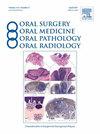种植体支撑的单冠和固定义齿固位力的体外研究
Oral surgery, oral medicine, oral pathology, oral radiology, and endodontics
Pub Date : 2022-02-11
DOI:10.3390/oral2010005
引用次数: 1
摘要
本体外研究的目的是研究三种不同的骨水泥提供半永久性骨水泥的适用性,并比较种植体支持的单冠(SC)和使用这些骨水泥的三单元固定义齿(FDP)的固位力。提供24个甲基丙烯酸酯模型,每个模型有3个种植体/基台来模拟SCs/ fdp的情况。制备钴铬骨架,喷砂(Al2O3/50µm/0.2 MPa),然后用玻璃离子聚合物(KTC)、聚羧酸盐(DUR)或自粘树脂水泥(RXU)进行胶结。标本在盐溶液(NaCl/37℃/24 h)中保存或进行热循环。使用万能试验机和拉脱装置去除覆层。多因素方差分析结果显示,不同骨水泥对SCs的固位力存在显著差异(p < 0.05)。NaCl储存后的平均固相力(以牛顿为单位)为(SCs/ fdp): KTC 170/352, DUR 409/406, RXU 265/426,热循环后的平均固相力(SCs/ fdp): KTC 156/262, DUR 306/380, RXU 494/508。与SCs相比,fdp具有更高的保留值。对于sc,人工热循环老化导致RXU保留率显著增加,而KTC和DUR保留率降低。玻璃离聚体可作为半永久性水泥用于SCs和fdp。聚羧酸水泥在老化一年后被认为是半永久性的。本文章由计算机程序翻译,如有差异,请以英文原文为准。
Retention Forces of Implant-Supported Single Crowns and Fixed Dental Prostheses after Cementation: An In-Vitro Study
The aim of this in vitro study was to investigate three different cements for their suitability to provide semi-permanent cementation, and to compare the retention forces of implant-supported single crowns (SC) and three-unit fixed dental prostheses (FDP) luted with these cements. Twenty-four methacrylate models were supplied with three implants/abutments each to simulate the condition of SCs/FDPs. Cobalt-chromium frameworks were fabricated, sandblasted (Al2O3/50 µm/0.2 MPa) then cemented with glass-ionomer (KTC), polycarboxylate (DUR) or self-adhesive resin cement (RXU). Specimens were stored in a saline-solution (NaCl/37 °C/24 h) or subjected to thermocycling. A universal testing machine and a pull-off device were used to remove the copings. The multi-factor ANOVA showed that the retention force differed significantly among all cements for the SCs after NaCl storage (p < 0.05). Mean retention forces (in Newtons) after NaCl storage were (SCs/FDPs): KTC 170/352, DUR 409/406, RXU 265/426, and after thermocycling (SCs/FDPs): KTC 156/262, DUR 306/380, RXU 494/508. FDPs showed higher retention values in comparison to SCs. For SCs, artificial aging with thermocycling resulted in a significant retention increase for RXU, whereas the retention of KTC and DUR was decreased. Glass ionomer can be used as a semi-permanent cement for both SCs and FDPs. Polycarboxylate cement is considered semi-permanent after one year of aging.
求助全文
通过发布文献求助,成功后即可免费获取论文全文。
去求助
来源期刊
自引率
0.00%
发文量
0
审稿时长
1 months

 求助内容:
求助内容: 应助结果提醒方式:
应助结果提醒方式:


